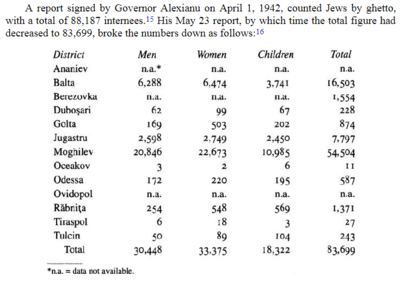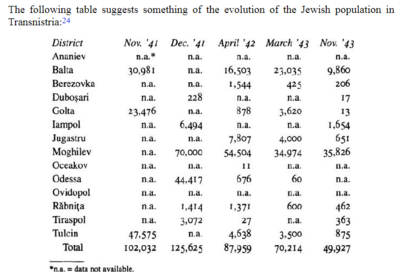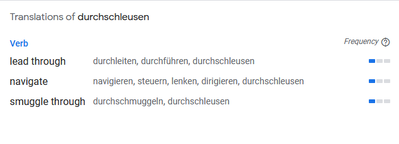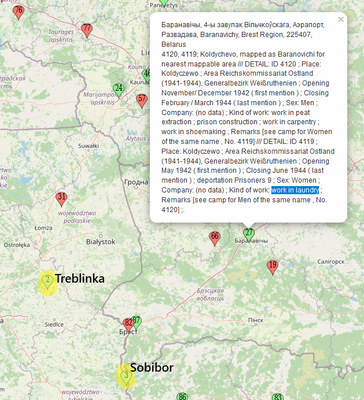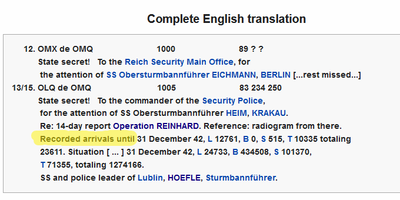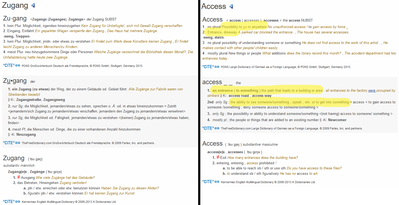In an earlier post, I noted that the word used by Korherr in his statement about Jews sent "through the camps in the General Government" was the German word "durch", meaning
through. However, the actual phrase used was, "Es wurden
durchgeschleust durch die Lager im Generalgouvernement.....................". Original German is here:
The verb used here is "durchschleusen", conjugated into its past participle form as "durchgeschleust". Here is what it means:
This is a compound word, so we can break it down further into parts to better understand the meaning. Since we know "durch" essentially means "through", the word "durchgeschleust" can be broken down with "geschleust" ("schleusen"), which means:
All of this is just to give a much clearer picture of the fact that Korherr was indeed referring to the
sifting / channeling / navigating / funneling / smuggling through the "camps in the General Government".
What is extremely important to understand is that nowhere in this document does Korherr mention AR camps. He refers to "camps in the General Government", of which it turns out there are hundreds thus far known and likely hundreds more not yet known (or thousands, if we include all concentration/collection sites and not just labor camps).
Jews were
channeled through the camps in the General Government (and through the Warthegau).
Also important to understand is that they were sent
toward the Russian East (not
necessarily "to", as has been the common interpretation). I showed in an earlier post on this thread that "toward" and "toward" (or "for") are all valid translations of the word "nach". Additionally, when speaking specifically of a transit between one location/place to another, it appears that "toward" is the more accurate translation for "nach", per Google:
Although other parts of this document use "nach" in ways that might imply a more immediate destination (such as "nach Theresienstadt"), the word is flexible as shown. And of course, the Jews in question received "special treatment"; a term which applied to these channeled/sifted Jews, specifically. Korherr himself sought to find out what this meant and received an official answer:
It was precisely the term "special treatment" (sonderbehandlung) that motivated me to inquire of the RSHA by telephone what this term meant. I received the answer that it referred to Jews who would be settled in the District of Lublin.
http://fpp.co.uk/History/General/Korher ... 50777.htmlOf course, some of these Jews were sent along the line with the destination of "T", for "Treblinka" (shown in the Hoefle telegram), which was north of the Lublin district. But these Jews, too, would have been considered as having been sent to "Lublin" or the Lublin district/system/etc.:
Interrogator: “What was Camp T?”
Wisliceny: “If I correctly recollect, that belonged to the complex Lublin system. I remember having heard the designation Camp T”.
Thus, we have Jews being sent:
1) out of the eastern provinces,
2) toward the Russian East.
3) channeled/sifted through the camps in the General Government,
4) settled (or at work) in the "greater Lublin district" area
5) some unknown number of these still ending up further east ^ This is what the Korherr report
actually states. This "channeling/sifting" is no doubt a component of the "special treatment" referred to in this same document (which could also refer to the dispossession of these Jews... I'll address this further in a moment). If we are to be so bold as to interpret the Korherr report literally---that it refers to the "evacuation" of the Jews and not extermination---this report simply describes how many Jews were evacuated from the ghettos, sent east to work or to be settled, and designated as ultimately destined for the Russian East.
This document tells us nothing about how many Jews even made it to camps Belzec, Sobibor, Treblinka.
The other well-known document which the establishment says does claim to demonstrate the number of
arrivals is the Hoefle telegram. Here it is:
It translates roughly as the following:
Secret Reich matter! To the commander of the security police, for the attention of SS Obersturmbannfuhrer HEIM, KRAKAU. Re: 14-day report operation REINHART. Reference: there. Fs. Access until 31.12.1942, L 12761, B O, S 515, T 10335 together 23611. Stand... 31.12.1942, L 24733, B 434508, S 101370, T 71355, together 1274166.
SS and Pol.fuhrer LUBLIN, HOEFLE, Sturmbannfuhrer.
Since we know that the same figure in the telegram of 1,274,166 refers to the Jews (in the Korherr report) who were evacuated out of the ghettos then "channeled/sifted through the camps in the General Government [toward the Russian East]", and since it is further confirmed which of the "camps in the General Government" are being referred to by the lengthy stops at the sites of
numerous labor camps (along with roadways/connections to even more labor camps; see:
viewtopic.php?f=2&t=14847&p=107640#p107640),
the notion that the number of Jews who were evacuated out of the ghettos are precisely the same number that arrived at the camps of Belzec, Sobibor, or Treblinka at the far-eastern end of the "Lublin camp system" is unfeasible. Thus, we are forced to consider alternative interpretations to the Hoefle telegram other than that the numbers reported were Jews who had all physically arrived at the Belzec / Sobibor / Treblinka camps by the time the report was made. To do so, there are some key factors to keep in-mind:
- The key and critical functions of the Lublin district and surrounding network were transit and [consolidation, dispatching, utilization of] labor. Explained here: viewtopic.php?f=2&t=14847#p107650
- The purpose and function of 'Aktion Reinhard' was the confiscation and utilization of Jewish property. See the post linked and the one after it, here: https://forum.axishistory.com/viewtopic ... 3#p2319478
- The word used in the Hoefle telegram to describe the relation between the numbers/figures provided and "B", "S", and "T" (and "L"), is the word "Zugang", written as "Fs. Zugang bis..."
Regarding the first point above, this context (transit, labor) is crucial to understanding why Jews might have been sent here (Lublin district), ending up at any of the labor camps along the line and/or being resettled (temporarily or permanently) in the "greater Lublin" area.
When you have a central hub that serves a purpose of sending out resources and labor to all of occupied Europe, you need to have labor resources at-the-ready! And what is the best way to organize this sort of labor, which arrives in [greater] Lublin district on trains from a west-to-east direction? Well, you have them at camps and sites that run along (or nearby) that same line. You might even categorize them accordingly (e.g. those who were along the Treblinka line being categorized as "T", as they remain in a sector which is still relevant to the Treblinka "gate" leading further east). This type of "special treatment" that is fully compatible with the Korherr report and also explains the Hoefle telegram (more on that in a moment). Jews who were given "special treatment" were not sent
directly to the Russian East. They were sent to greater Lublin district.
On the second point above, PrudentRegret has made an excellent case which shows that "Aktion Reinhard" at its core was all about the confiscation (and utilization) of Jewish property. Any significance given to these camps regarding their secrecy or as it pertains to "special treatment", etc. had everything to with this policy of confiscation and management of Jewish property. Whereas many Jews disembarked before the trains ever reached Belzec / Sobibor / Treblinka / Lublin, their property continued onto this point, where it was sorted and then further managed. Note there are additional sites related to property sorting (warehouse, laundry) among those labor camps nearest to the border where Treblinka and Sobibor lie:
Clearly, property-sorting was a key focus for the area and the lines running through them.
On the third point I listed above, I note that the word on the Hoefle telegram is "Zugang" written as "Fs. Zugang bis...". Wikipedia seems to think this phrase means "Recorded arrivals until...", which suggests the "Fs." may indicate an abbreviation for "Recorded":
I do not currently have any way to verify this and Wikipedia does not explain how this was determined (yet this could be significant to understand exactly what is being said). In any case, it is what follows that would seem to be of at least similar importance ("Zugang bis..."). Here are the top translations, per Google, for "Zugang":
And for "bis", the top translations are:
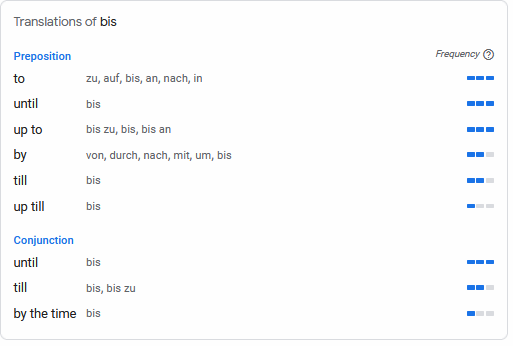
- bis.png (11.18 KiB) Viewed 249 times
Although "bis" can frequently mean "to", putting both words together ("Zugang bis"), pretty consistently delivers "Access until", including when referring to a point in time which is what is done in the Hoefle telegram ("Fs. Zugang bis 31.12.1942..."):
Since the "until" portion pretty clearly refers to the date which is noted, the word that we really need to consider is "Access". What does "access"
really mean?
Whether as a noun or a verb, it is clear that
this word can as much apply to those who have approached, are on the path of, etc. a given position as those whom have already physically arrived or passed through. I have access to my local gym, as a member. It doesn't mean I am already there. Just to clarify whether the definition of "access" in English compares to the definition of "Zugang" in German, here's how the definition is described in a German dictionary (Google-translation of the same page provided for non-German readers):
"The
possibility to go in..."
"Entrance,
driveway"
"the
path that leads to..."
"
the ability... to get into something"
"Fs. Zugang bis 31.12.1942...", as written in the Hoefle telegram, simply indicates that the listed number of Jews had accessed the [greater] Lublin district system by that time, via the corresponding routes as indicated by "T", "S", "B", and "L" in the Hoefle telegram. Each of these routes corresponded to a territory which was tied to both (1) transit further east, as needed or requested, and (2) 'Aktion Reinhard' sites for the confiscation of property at the end of each "access aisle". Hoefle was, of course, SS and Police Leader in the District of Lublin as well as Commander of the main department of Aktion Reinhard, so all of this should be kept in-mind when interpreting his telegram, factoring in what we now understand as outlined above.
Here is a question, treat it as a hypothetical: what would be the most
efficient way to organize a system which transits Jews from further west to the 'premier labor and transit center of all of ''Nazi Europe', intending to station them there until needed, with all property ending up at the major "gates" at the end of each respective line? What would be the most likely way to do this, especially if the same person [Hoefle] was in command of both the Lublin district as well as the 'Aktion Reinhard' property-confiscation operation? If you were him,
you would organize the entire system based upon these lines. Labor camps and other important sites would be associated with these routes, as would the Jews (labor) within that same "complex Lublin system".
When Hoefle reported on Jews who had accessed "T", "S", "B", "L"; he identified the total number available for labor (or perhaps including any simply pending resettlement) in each of the corresponding areas. Additionally or alternatively, he may have been using these figures as an indication of how much property (or from how many Jews said property) had been obtained. Most likely, he is simply using the figures of Jews
deported out of the Eastern Provinces for these purposes, rather than having any special data about how many "arrived" at any exact, physical location. This explains why Korherr's figure (meant to show the number of Jews who "
evacuated" the Eastern Provinces through the GG) is the same as Hoefle's (showing the number who "
arrived" in the [greater] Lublin district).
[Quick note: for those who are not aware, the confiscation of Jewish property was a
secret operation. There is abundant evidence that it was treated this way. Thus, the Korherr report, Hoefle telegram and other 'Reinhard-relevant' documents being indicated as a "secret Reich matter" is still perfectly-aligned with what I've outlined above, as is any other evidence the program was kept secret.]
Obviously, these particular Jews had received "special treatment" in not being sent
directly to the Russian East, instead being put to work or settled locally until an appropriate time (or perhaps staying put until the end of the war). They had also received "special treatment" by being dispossessed along the way.
Lastly, I'll respond to the following:
DissentingOpinions wrote:In Korherr’s report, he says that the evacuated Jews are not in ghettos or camps - even if he was excluding Ostland ghettos, Himmler declared late into Aktion Reinhardt that they were to be closed & their inhabitants be transited further east. Further east was the Eastern Front, then Russia, then the Far East. Hence, these Jews were brought into the Russian Far East. Whether or not they were murdered in gulags is unknown.
Korherr adds this description to Section V of his report however you need to also consider the fact that not all evacuated Jews received "special treatment"---only those channeling/sifting through camps in the GG and Warthegau. There is no indication that 'camps in the General Government / Warthegau' means Treblinka, Sobibor, Belzec, etc. There were hundreds of labor camps along these routes, and the Fahrplanordnung documents show lengthy stops at only these general locations, for which there is no rational explanation but the off-boarding and/or exchange of labor (and perhaps other settlers). Korherr not only indicates on his report that the Jews from the Eastern Provinces would receive "special treatment" but later confirms that this means those within that category would be "settled in the Lublin district". He does not specify the details of this settlement (e.g. temporary vs. permanent) and presumably did not bother to ask, but seems to have found the explanation sufficient for his purposes. Other interpretations of "special treatment" can include those relevant to Aktion Reinhard as it pertains to confiscation of property. All of these interpretations are valid insofar as Hoefle oversaw the relevant jurisdictions in both Lublin and AR.


